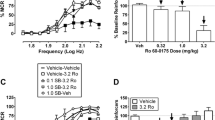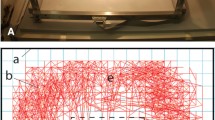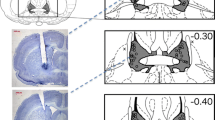Abstract
Rationale
Intra-median raphé nucleus (MRN) administration of the 5-HT1A receptor agonist 8-OH-DPAT decreases lateral hypothalamic self-stimulation thresholds and is reported to have biphasic effects following systemic administration. These experiments attempted to extend the previous findings to mesolimbic pathway self-stimulation at ventral tegmental area (VTA) electrodes.
Objectives
This study was conducted to provide comparative data for systemic and intra-dorsal raphé nucleus (DRN) and intra-MRN effects of 8-OH-DPAT on VTA self-stimulation.
Methods
Male Sprague-Dawley rats with VTA electrodes were trained to respond for electrical stimulation. Systemic and intra-midbrain raphé 8-OH-DPAT effects on rate-frequency thresholds were measured. Systemic administration of WAY 100635 was used to confirm 5-HT1A receptor mediation of 8-OH-DPAT effects.
Results
8-OH-DPAT (0.003–0.3 mg kg−1 SC) increased rate-frequency thresholds and decreased maximal response rates. WAY 100635 alone (0.0125–0.1 mg kg−1 SC) did not alter these measures. Intra-DRN and intra-MRN 8-OH-DPAT (5.0 μg) decreased rate-frequency thresholds without altering maximal response rates. Intra-DRN 8-OH-DPAT (0.1–5.0 μg) induced a slight decrease and intra-MRN 8-OH-DPAT a slight increase in locomotor activity. WAY 100635 (0.1 mg kg−1) blocked effects of 8-OH-DPAT on VTA self-stimulation.
Conclusion
These results confirm threshold-decreasing effects of intra-MRN 8-OH-DPAT and extend this to the DRN and to VTA thresholds. Monophasic dose dependent increases in VTA thresholds following systemic 8-OH-DPAT are not equivalent to reports for hypothalamic self-stimulation. Differences between studies may be attributable to stimulation site and/or differences in threshold measurement procedures. Effects of WAY 100635 in this study indicate 5-HT1A receptor mediation of these 8-OH-DPAT effects.




Similar content being viewed by others
References
Arvidsson L-E, Hacksell U, Nilsson JLG, Hjorth S, Carlsson A, Lindberg P, Sanchez D, Wikström H (1981) 8-Hydroxy-2-(di-n-propylamino) tetralin, a new centrally acting 5-hydroxytryptamine receptor agonist. J Med Chem 24:921–923
Aznar S, Qian Z, Shah R, Rahbek B, Knudsen GM (2003) The 5-HT1A serotonin receptor is located on calbindin- and parvalbumin-containing neurons in the rat brain. Brain Res 959:58–67
Barnes NM, Sharp T (1999) A review of central 5-HT receptors and their function. Neuropharmacology 38:1083–1152
Benloucif S, Galloway MP (1991) Facilitation of dopamine release in vivo by serotonin agonists: studies with microdialysis. Eur J Pharmacol 200:1–8
Blaha CD, Phillips AG (1990) Application of in vivo electrochemistry to the measurement of changes in dopamine release during intracranial self-stimulation. J Neurosci Meth 34:125–133
Boess FG, Martin IL (1994) Molecular biology of 5-HT receptors. Neuropharmacology 33:275–317
Cervo L, Rozio M, Ekalle-Soppo CB, Carnovali F, Santangelo E, Samanin R (2002) Stimulation of serotonin1B receptors induces conditioned place aversion and facilitates cocaine place conditioning in rats. Psychopharmacology 163:142–150
Chen J, Paredes W, Van Praag HM, Gardner EL (1992) Serotonin denervation enhances responsiveness of presynaptic dopamine efflux to acute clozapine in nucleus accumbens but not in caudate-putamen. Brain Res 582:173–179
Choi KH, Zarandi B, Todd KG, Biondo AM, Greenshaw AJ (2000) Effects of AMPA/kainate receptor blockade on responses to dopamine receptor agonists in the core and shell of the rat nucleus accumbens. Psychopharmacology 150(1):102–111
Dourish CT, Hutson PH, Curzon G (1986) Putative anxiolytics 8-OH-DPAT, buspirone and TVXQ 7821 are agonists at 5-HT1A autoreceptors in the raphé nuclei. Trends Pharmacol Sci 7:212–214
Dray A, Davies J, Oakley NR, Tongroach P, Vellucci S (1978) The dorsal and medial raphé projections to the substantia nigra in the rat: electrophysiological, biochemical and behavioural observations. Brain Res 151:431–442
Drescher K, Hetey L (1988) Influence of antipsychotics and serotonin antagonists on presynaptic receptors modulating the release of serotonin in synaptosomes of the nucleus accumbens of rats. Neuropharmacology 27:31–36
Fiorino DF, Coury A, Fibiger HC, Phillips AG (1993) Electrical stimulation of reward sites in the ventral tegmental area increases dopamine transmission in the nucleus accumbens of the rat. Behav Brain Res 55:131–141
Fletcher PJ (1994) Effects of 8-OH-DPAT, 5-CT and muscimol on behaviour maintained by a DRL20 schedule of reinforcement, following microinjection into the dorsal or median raphe nuclei. Behav Pharmacol 5:326–336
Fletcher PJ (1996) Injection of 5-HT into the nucleus accumbens reduces the effects of d-amphetamine on responding for conditioned reward. Psychopharmacology 126:62–69
Fletcher PJ, Korth KM (1999) Activation of 5-HT1B receptors in the nucleus accumbens reduces amphetamine-induced enhancement of responding for conditioned reward. Psychopharmacology 142:165–174
Fletcher PJ, Ming ZH, Higgins GA (1993) Conditioned place preference induced by microinjection of 8-OH-DPAT into the dorsal or median raphe nucleus. Psychopharmacology 113:31–36
Fletcher A, Bill DJ, Cliffe EA, Forster IA, Reilly Y (1994) A pharmacological profile of WAY 100635, a potent and highly selective 5-HT1A receptor antagonist. Br J Pharmacol 112:91–98
Fletcher PJ, Tampakeras M, Yeomans JS (1995) Median raphé injections of 8-OH-DPAT lower frequency thresholds for lateral hypothalamic self-stimulation. Pharmacol Biochem Behav 52:65–71
Fletcher PJ, Korth KM, Chambers JW (1999) Selective destruction of brain serotonin neurons by 5,7-dihydroxytryptamine increases responding for a conditioned reward. Psychopharmacology 147:291–299
Forster EA, Cliffe IA, Bill DJ, Dover GM, Jones D, Reilly Y, Fletcher A (1995) A pharmacological profile of the selective silent 5-HT1A receptor antagonist, WAY 100635. Eur J Pharmacol 281:81–88
Gallistel CR, Karras D (1984) Pimozide and amphetamine have opposing effects on the reward summation function. Pharmacol Biochem Behav 20:73–77
Greenshaw AJ (1986) Electrical and chemical stimulation of brain tissue in vivo. In: Boulton AA, Baker GB (eds) Neuromethods: neurochemistry: general techniques, vol. 1. Humana Press, Clifton, N.J., pp 233–277
Greenshaw AJ (1993) Differential effects of ondansetron, haloperidol and clozapine on electrical self-stimulation of the ventral tegmental area. Behav Pharmacol 4:479–485
Greenshaw AJ (1997) A simple technique for determining stereotaxic coordinates for brain implantation of probes at rotated angles in one or two planes. J Neurosci Meth 78:169–172
Greenshaw AJ, Wishart TB (1987) Drug action and reward processes. In: Greenshaw AJ, Dourish CT (eds) Experimental psychopharmacology: concepts and methods. Humana Press, Clifton, N.J., pp 299–340
Harrison AA, Markou A (2001) Serotonergic manipulations both potentiate and reduce brain stimulation reward in rats: involvement of serotonin-1A receptors. J Pharmacol Exp Ther 297:316–325
Harrison AA, Parsons LH, Koob GF, Markou A (1999) RU 24969, a 5-HT1A/1B agonist, elevates brain stimulation reward thresholds: an effect reversed by GR 127935, a 5-HT1B/1D antagonist. Psychopharmacology 141:242–2500
Higgins GA, Elliott PJ (1991) Differential behavioural activation following intra-raphé infusion of 5-HT1A receptor agonists. Eur J Pharmacol 193:351–356
Hillegaart V (1990) Effects of local application of 5-HT and 8-OH-DPAT into the dorsal and median raphé nuclei on motor activity in the rat. Physiol Behav 48:143–148
Hillegaart V (1991) Functional topography of brain serotonergic pathways in the rat. Acta Physiol Scand 142(suppl.):1–54
Hillegaart V, Hjorth S (1989) Median raphé, but not dorsal raphé, application of the 5-HT1A agonist 8-OH-DPAT stimulates rat motor activity. Eur J Pharmacol 160:303
Hillegaart V, Wadenberg ML, Ahlenius S (1989) Effects of 8-OH-DPAT on motor activity in the rat. Pharmacol Biochem Behav 32:797–800
Hogg S, Andrews N, File SE (1994) Contrasting behavioural effects of 8-OH-DPAT in the dorsal raphé nucleus and ventral hippocampus. Neuropharmacology 33:343–348
Hoyer D, Martin G (1997) 5-HT receptor classification and nomenclature: towards a harmonization with the human genome. Neuropharmacology 36:419–428
Ivanová S, Greenshaw AJ (1997) Nicotine-induced decreases in VTA electrical self-stimulation thresholds: blockade by haloperidol and mecamylamine but not scopolamine or ondansetron. Psychopharmacology 134:187–192
Jones DE, Haskins JT (1991) Neurophysiological studies of (±)-WAY100135: a novel and highly selective 5-HT1A receptor antagonist. Soc Neurosci Abstr 17:91
Jones S, Kauer JA (1999) Amphetamine depresses excitatory synaptic transmission via serotonin receptors in the ventral tegmental area. J Neurosci 19(22):9780–9787
Joyce JN, Goldsmith SG, Gurevich EV (1997) Limbic circuits and monoamine receptors: dissecting the effects of antipsychotics from disease processes. J Psychiatr Res 31:197–217
Kalivas PW (1993) Neurotransmitter regulation of dopamine neurons in the ventral tegmental area. Brain Res Rev 18:75–113
Lorrain DS, Arnold GM, Vezina P (1999) Mesoaccumbens dopamine and the self-administration of amphetamine. Ann N Y Acad Sci 877:820–822
Meltzer HY (1999) The role of serotonin in antipsychotic drug action. Neuropsychopharmacology 21:106S–115S
Miquel MC, Doucet E, Riad M, Adrien J, Verge D, Hamon M, Miquel MC, Doucet E, Riad M et al. (1992) Effect of the selective lesion of serotoninergic neurons on the regional distribution of 5-HT1A receptor mRNA in the rat brain. Brain Res Mol Brain Res 14:357–362
Montgomery AMJ, Rose IC, Herberg LJ (1991) 5-HT1A agonists and dopamine: the effects of 8-OH-DPAT and buspirone on brain-stimulation reward. J Neural Transm 83:139–148
Muramatsu M, Lapiz MD, Tanaka E, Grenhoff J (1998) Serotonin inhibits synaptic glutamate currents in rat nucleus accumbens neurons via presynaptic 5-HT1B receptors. Eur J Neurosci 10:2371–2379
Parsons LH, Weiss F, Koob GF (1998) Serotonin1B receptor stimulation enhances cocaine reinforcement. J Neurosci 18:10078–10089
Paxinos G, Watson C (1986) The rat brain in stereotaxic coordinates, 2nd edn. Academic Press, New York
Phillips AG, Fibiger HC (1989) Neuroanatomical bases of intracranial self-stimulation, untangling the Gordian Knot. In: Liebman JM, Cooper SJ (eds) Neuropharmacological basis of reward. Oxford University Press, Oxford, UK, pp 66–105
Phillips AG, Coury A, Fiorino D, LePiane FG, Brown E, Fibiger HC (1992) Self-stimulation of the ventral tegmental area enhances dopamine release in the nucleus accumbens: a microdialysis study. Ann N Y Acad Sci 654:199–206
Tomkins DM, O’Neill (2000) Effect of 5-HT1B ligands on self-administration of ethanol in an operant procedure in rats. Pharmacol Biochem Behav 66:129–136
Vertes RP (1988) Brainstem afferents to the basal forebrain in the rat. Neuroscience 24:907–935
Vertes RP, Martin GF (1988) Autoradiographic analysis of ascending projections from the pontine and mesencephalic reticular formation and the median raphé nucleus in the rat. J Comp Neurol 275:511–541
Wise RA (2002) Brain reward circuitry: insights from unsensed incentives. Neuron 36:229–240
Wogar MA, Bradshaw CM, Szabadi E (1991) Evidence for an involvement of 5-hydroxytryptaminergic neurones in the maintenance of operant behaviour by positive reinforcement. Psychopharmacology 105:119–124
Acknowledgements
This work was supported by an operating grant from the Canadian Institutes of Health Research. RC was the recipient of NSERC scholarship funding. The excellent technical assistance of David Epp is gratefully acknowledged.
Author information
Authors and Affiliations
Corresponding author
Rights and permissions
About this article
Cite this article
Ahn, KC., Pazderka-Robinson, H., Clements, R. et al. Differential effects of intra-midbrain raphé and systemic 8-OH-DPAT on VTA self-stimulation thresholds in rats. Psychopharmacology 178, 381–388 (2005). https://doi.org/10.1007/s00213-004-2031-3
Received:
Accepted:
Published:
Issue Date:
DOI: https://doi.org/10.1007/s00213-004-2031-3




